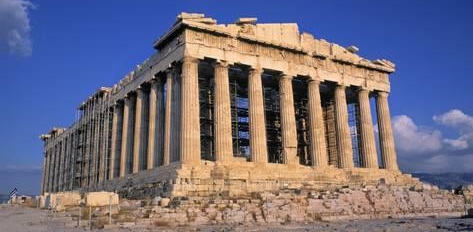
1. Why study perception?
2. What is perception?
3. What is Cognitive Science?
4. What are three implications of the Cognitive Science approach to the study of perception?
5. Describe the tri-level hypothesis.
6. Define functional architecture.
7. How does the functional architecture provide two ways to escape from Ryle’s Regress?
8. What is the difference between strong and weak equivalence, and what does this imply for models in psychology?
9. What are some themes in vision science?
Goals of perception:
• to understand human ________ structures and processes
e.g., sensory systems, brain
• to understand (and overcome) ______ in observation
e.g., visual illusions: misperceptions due to processing in the visual system; result in a percept that differs from reality (vs. optical illusions that use optics like lenses or mirrors)
e.g., real-world implications of illusions
• to create substitutes/auxiliaries for ________ senses
e.g., Braille, hearing aids
• to replace the real world with ___________
e.g., stereo, surround sound
• to replace the ________ with substitutes
e.g., robotic vision
Non-trivial due to differences between physical world and perceived world:
• situations of _________________ between the two
• sense organs are _______
• physical objects must be ________ to be perceived
• individual ___________ among people
(Coren, Ward, & Enns, 2004)

- Doric temple of Athena, built in the 5th century BCE on the Acropolis of Athens
- architects were Iktinos and Kallikrates
- its horizontal lines seem straight and parallel, and its columns seem straight and vertical
- but it was constructed in a _________ manner to offset a number of visual illusions
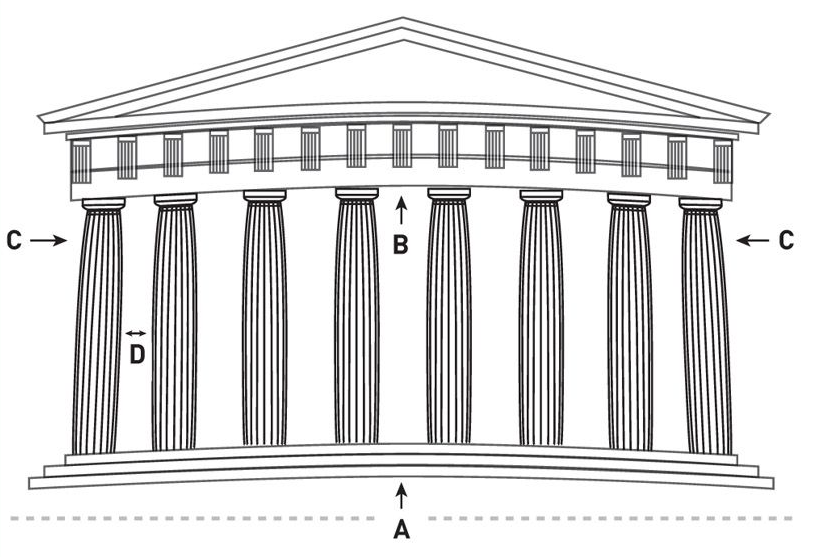
1. _____ horizontal lines
• placing angles above a line (as the roof is above the architrave) causes the line to appear slightly bowed
- the ends of the horizon line appear slightly higher than the centre:

- this is known as the Wundt illusion:
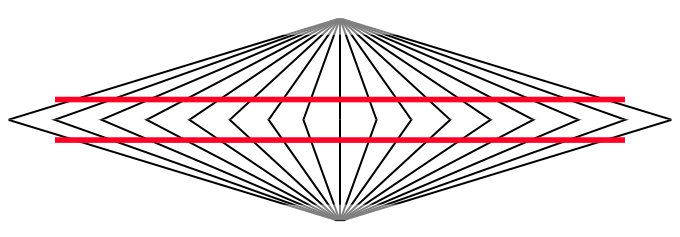
• the building was altered to compensate for this illusion: [A] and [B]
- the upward curvature is > 6 cm on the east and west walls (almost 11 cm on the longer north and south walls):
2. apparent ___________ of vertical lines
• rising objects appear to fall outward at the top
• columns are not ________, they are inclined 7 cm inwards to compensate for the illusion: [C]
- if projected upwards, they would meet at a point 2 km above the building
3. light/dark ________ effects
• columns seen against the sky (i.e., corner columns) seem thinner than those seen against the darker background of the interior wall: [D]
- the corner columns were made 6 cm ______ in diameter, and 25 cm more widely spaced to compensate
4. _____ vertical lines of columns
• straight, parallel lines seem to converge inwards
• columns constructed to bulge slightly in the middle to compensate (_______):
- entasis of different columns ranges from 1.75 to 2.45 cm
- if the Parthenon were constructed to be geometrically square, it would not be ____________ square:

• _________: simple sensory experience elicited by a stimulus; conversion of energy or chemicals to a neural code
e.g., “senses” are vision, audition, gustation, olfaction, touch, warmth, cold, pain, kinesthesis, proprioception, and vestibular sense
• __________: conscious experience of objects; organization and interpretation of neural signals
e.g., recognition or identification of an object, based on sensations
Since the demise of the Gestalt movement:
|
“...students of the psychology of perception have made no serious attempts at an overall _____________ of what perception is, concentrating instead on the analysis of properties and performance” (David Marr, 1982, p.9). |
A psychologist’s understanding of “what perception is” is more than the analysis of perceptual properties and ___________?
To gain a full understanding of what perception is, the fundamental assumption made in this course is: perception is ___________ __________.
- the scientific study of the mind as an information processor
- an _________________ field, consisting of: anthropology, computing science, education, linguistics, neuroscience, philosophy, and psychology
- includes the study of artificial intelligence, attention, language processing, learning and development, memory, perception, and action
- research methods include traditional behavioural experiments, brain imaging, computational modeling, and neurobiological methods
- Cognitive Science Society: organization of cognitive scientists; publishes journals and holds an annual meeting to share research
Information Processing
- describes the behaviour of a particular kind of device: an information processor
- the mind, viewed as an information processor, is: “a complex system that receives, stores, retrieves, transforms, and transmits information” (Stillings et al., 1987, p.1)
- this is done by being able to process information (“data”) according to a set of rules or procedures (a “program”)
- implications:
• perception must be given an ________________ account (i.e., described in terms of the physical structures involved)
• perception must be given a ______ account (i.e., described in terms of the underlying functions and knowledge structures)
• perception must be given an ________________ account (i.e., described in terms of the behaviours observed)
________________ Aspects of Perception
- it must be explained how perceptual procedures are physically realized in the “wetware” of the brain
• How can perceptual information processing be related to biological structures?
Marr’s loss of implementational innocence...
|
“I was myself fully caught up in this excitement. Truth, I also believed, was basically neural, and the central aim of all research was a thorough functional analysis of the structure of the central nervous system. My enthusiasm found expression in a theory of the cerebellar cortex. “...The way seemed clear. On the one hand, we had new experimental techniques of proven power, and on the other, the beginnings of a theoretical approach that could back them up with a fine analysis of cortical structure... “...But somewhere underneath, something was going wrong... “...it gradually became clear that something important was missing that was not present in either of the disciplines of neurophysiology or psychophysics... “What are the visual areas of the cerebral cortex actually doing?” (Marr, 1982, pp.14-15) |
...led Marr to found the discipline of _____________ ____________.
Implementation is not enough!
- perception researchers have, for a long time, focused on trying to understand the __________ of perception
![]() perceptual phenomena can be reduced to the causal laws of neurophysiology
perceptual phenomena can be reduced to the causal laws of neurophysiology
![]() may lead to an __________ theory
may lead to an __________ theory
![]() not general enough to capture individual commonalities in the wake of individual differences
not general enough to capture individual commonalities in the wake of individual differences
![]() describes, but does not _______
describes, but does not _______
|
“...trying to understand perception by only studying neurons is like trying to understand bird flight by studying only feathers: It just cannot be done” (Marr, 1982, p.27). |
Formal Aspects of Perception
- information processes are ______: represented in symbols and abstract structures
- symbols have no intrinsic meaning, but token type is important
e.g., words “run” vs. “rum” (verb vs. noun)
- rules are formal; they only depend on token ____
e.g., classic formal system: a game of _____ (the form of the pieces is arbitrary; game depends on the token type)
Focus for a formal account:
- must be on the percepts or internal symbols that represent the external world
- and on the specific procedures used to solve information processing problems
- to use an analogy, this account describes the “____” and “________ _______” used by the perceptual system
- thus, a formal account must focus on the following kinds of questions:
• What ________ structures are used to represent perceptual information?
• What __________ are used to manipulate these structures?
• How are these procedures ___________ and controlled?
Interpretational Aspects of Perception
- the power of a formal system is that its symbol manipulation can be assigned some meaning--an interpretation
- for Marr, a statement of a system’s interpretation is called a _____________ ___________: merely a description of what a system is doing
- an interpretational account of a perceptual process will answer questions like the following:
• What information processing problems are being solved by a perceptual system?
• What is the system doing, and why? (This includes behaviours.)
The Three Levels (Marr, 1982):
1. _____________ ______
• ___________ level
• What is the goal of the computation?
• Why is it appropriate?
• What is the logic of the strategy by which it can be carried out?
• methods: logic, mathematics, philosophy
2. ______________ and _________
• __________ level
• How can this computational theory be actualized?
• What is the representation for the input and the output?
• What is the algorithm for the transformation?
• methods: psychophysics, computer simulation
3. ________ ______________
• ________ level
• How can the representation and algorithm be realized physically?
• methods: neuroscience, electrical engineering
Marr’s research strategy: start with questions at the computational level, and work down to the hardware implementation
The Tri-Level Hypothesis:
- basic assumption: perception is ___________ __________
- this commits us to a particular research program--dictated by a particular philosophy of science
- this research program has the following main components:
• we must describe perception at each of the three levels of computation, representation/procedure, and implementation
• we must specify relationships among these three levels
• we must identify a __________ ____________ for perception
- the set of _________ __________ that make up an information processing system
- think of a computer ___________ ________: basic functions are organized to produce more complex ones; any computer language can be reduced to machine language instructions built into the CPU
e.g., mov ah, 09h
- another analogy: the “__________” from which all sentences in some language can be created
- or: the biologically fixed part of cognition
FA--structure vs. function:
- consider __________ architecture: what comprises a physical structure?
e.g., bread is based on the structure of gluten, a stretchy matrix of glutenin and gliadin that traps gases
e.g., Frank Gehry’s Guggenheim Museum in Bilbao: limestone blocks, titanium forms, glass curtain walls
- in contrast, the __________ architecture is made up of the basic steps that comprise a given function
e.g., long division for 1024 ÷ 8:
|
128 |
The three levels and the architecture:
- the FA is part of the __________ description of a system
- it serves as a bridge to the implementational description
Computation |
Representation and Algorithm Functional Architecture |
Implementation |
Why specify a functional architecture?
- the fundamental ____ of Cognitive Science is: to specify the functional architecture of the mind
- why?
• all information processing systems have FA
• the FA is required to make an information processing account an ___________
• the FA is required to create ________ __________ models
Functionalism and explanation
- the functional architecture is indeed a functional account--it does not require a specification of physical mechanisms
- in general, the FA is eventually discovered by taking a very complicated functional description, and decomposing it into an organized description of simpler subfunctions: functional ________
- this approach, though, faces a tough scientific challenge: behaviourists would argue that it can only lead to descriptions, and not to explanations (called “Ryle’s _______,” after Gilbert Ryle, 1949)
e.g., colour perception ![]() processing of information in colour pathways
processing of information in colour pathways ![]() neural circuits
neural circuits ![]() neuroanatomy
neuroanatomy ![]() neurobiochemistry
neurobiochemistry ![]() chemistry
chemistry ![]() _______
_______ ![]() ?
?
- for explanations to occur, the functional decomposition must stop
- some criteria for exiting Ryle’s Regress:
1. Robert Cummins’ (1983) ___________ criterion:
(subsumption: incorporating something under a more general category)
• if a subfunction can be explained using natural, causal laws (e.g., physiological laws), it is considered to be primitive and decomposition can stop
e.g., colour vision was described functionally by James Clerk Maxwell and Hermann von Helmholtz in trichromatic theory, but was not subsumed until three different photopigment molecules were isolated in the 1960s
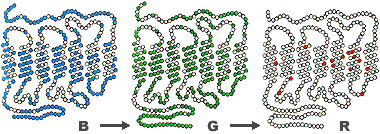
• there is no need to explain how (and why) molecules are photosensitive
2. Zenon Pylyshyn’s (1989; 1999) _________ _____________ criterion:
• if a perceptual phenomenon cannot be altered by a change in beliefs, then the function is cognitively impenetrable
• that is, if it is not changed by top-down processing (based on high-level cognitive processing), that implies it is bottom-up (based on low-level sensory processing), and thus must be handled by the FA
e.g., illusions, like simultaneous colour contrast
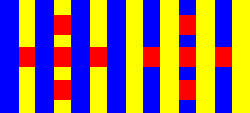
• even if you know what the colours actually are, it does not change the experience of the illusion
- the FA meets these kinds of criteria; thus, specifying the FA exits Ryle’s Regress
• What level of ___________ is required to be able to explain a phenomenon?
• Does the experience _______ despite changes in conscious knowledge?
An example: I have a computer system that plays _____ against me.
• In what ways are we the same?
• In what ways are we different?
The FA and bad models for psychology:
- from an engineering perspective, you just want to develop a system that accomplishes some task--but not necessarily in the same way as humans (“____ __”)
- such a system could pass a test of intelligence, but for the “wrong” reasons-- from a psychological perspective
- such models are called ______ __________ (Pylyshyn, 1984)
The FA and good models for psychology:
- from a Cognitive Science perspective, we want to develop models of human processes that exhibit the same behaviour, for the “right” reasons--the same underlying, fundamental processes are being used
- such models are called ________ __________ (Pylyshyn, 1984)
In essence, two information processing systems that are strongly equivalent are:
• performing the same ___________
• using the same “data” and “program”
• implemented on identical functional architectures
Functional Architecture and equivalence:
- two ______ equivalent systems:
Computation |
(same) |
Computation |
|
||
Representation and Algorithm Functional Architecture |
(different) |
Representation and Algorithm Functional Architecture |
|
||
Implementation |
(different) |
Implementation |
- two ________ equivalent systems:
Computation |
(same) |
Computation |
|
||
Representation and Algorithm Functional Architecture |
(same) |
Representation and Algorithm Functional Architecture |
|
||
Implementation |
(different) |
Implementation |
- ______ of Cognitive Science, applied to the modality of vision
- includes scientists in the domains of:
• _____________ and optometry
• neuroscience, neurology, and neuropsychology
• psychophysics, cognitive psychology, cognitive neuroscience
• computing science and engineering
- professional organizations hold annual meetings for vision scientists to share research:
• Vision Sciences Society
• Neural Correlate Society
- hosts the Best Illusion of the Year Contest
What Vision is Not (Enns, 2004):
• myth of seeing as a ________ record
- if vision were like a ______, visual illusions would not exist
e.g., Fraser spiral illusion (Fraser, 1908)
• myth of vision as a _______ process
- percept must be constructed from multiple stimuli
e.g., Belvedere (M.C. Escher, 1958)
• myth of the ______ ___
- where does perception take place?
e.g., Impressionists didn’t just paint “what the eye saw”
e.g., Waterlilies: Green Reflections (Monet, 1916-1923)
• myth of _________ _______
- visual imagery is important for cognition
e.g., Without using visual imagery, how many _______ are visible approaching the front door of your house?